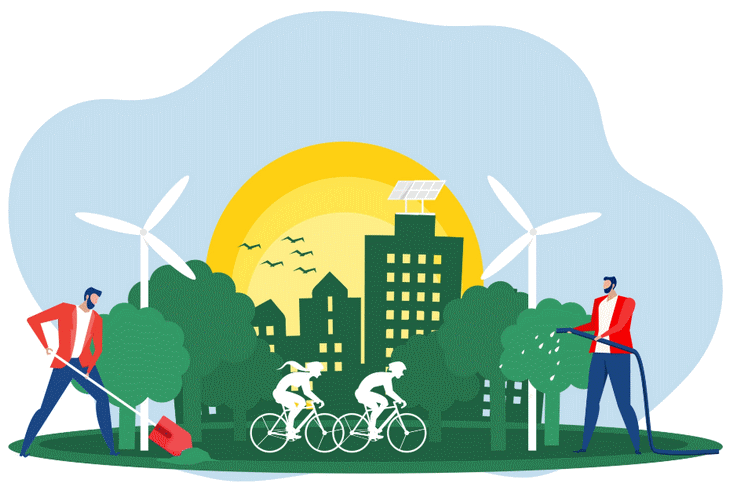April 2024
Microsoft: Carbon Negative Goal
Microsoft will be carbon-negative by 2030. By 2050, Microsoft will remove all carbon from the environment that it has emitted since its founding in 1975, either directly or through electrical consumption.

Microsoft's carbon-negative commitment is part of a long history of ambitious targets and actions to reduce greenhouse gas emissions. In 2009, Microsoft set its first greenhouse gas emissions target: a 30% reduction from 2007 levels by 2012. Since 2012, Microsoft has been operating carbon neutral. Like many other companies, it relied on investments in offsets that paid others not to emit carbon, rather than remove carbon dioxide.
The science and social and economic impacts of climate change drove the company to the conclusion that being carbon neutral alone is not enough, leading to the 2020 carbon-negative commitment. Historically, Microsoft focused on Scope 1 emissions (direct emissions from resources owned or managed) and Scope 2 emissions (indirect emissions from the generation of purchased electricity, steam, heating and cooling consumed by the company). Scope 3 includes all other indirect emissions that occur in a company's value chain. Therefore, the company now commits to be carbon negative for all three scopes by 2030.
Key facts
- With its internal carbon pricing funds, the company has purchased more than 30 billion kilowatt-hours (kWh) of green power, reduced its emissions by 20 million metric tons of carbon dioxide equivalent, positively impacted more than 8.2 million people in emerging countries through community projects with carbon filters, and saved more than $10 million per year.
- By 2020, Microsoft will have used 100% green power for its U.S. operations for the 6th consecutive year. Microsoft has been running ~95% on renewable energy since 2013 and has a long history of driving market development through innovative off-site, long-term contracts.
- Microsoft's Climate Innovation Fund, launched in 2020, commits to invest US$1 billion over a four-year period in new technologies and expand access to capital around the world for those working to address climate change.
The challenge
The science is clear: to avert the worst impacts of the rapidly changing climate, the world must shift to a low-carbon economy by 2050. To achieve net-zero emissions, the world must prioritize drastic reductions in all sectors, halving carbon emissions in the next 10 years.
The solution
Like many companies, Microsoft's pledge to become climate neutral was based on investing in offsets that paid others not to emit carbon, rather than removing carbon dioxide. The science and social and economic impacts of climate change drove the company to the conclusion that carbon neutral alone is not enough, leading to the carbon-negative pledge in 2020.
Microsoft's goal is not only for Microsoft to be carbon-negative by 2030, it also promises that by 2050 Microsoft will have removed from the environment all the carbon it has emitted since its founding in 1975, either directly or through electrical consumption. This Microsoft goal is also innovative because it is the first corporate goal that commits to removing historical emissions - essentially neutralizing the company's impact on the climate since its founding. In this way, the goal goes beyond aligning with the science of global emissions reduction paths. It introduces the concept of climate justice and equity into corporate GHG targets by pushing the boundary of responsibility from looking only ahead to both historical and future actions.

Helping People
Recognizing that climate and environmental issues do not affect all communities equally, Microsoft has made environmental equity a priority. In June 2020, Microsoft announced a new innovative partnership with Sol Systems (a renewable energy developer and investor that invests in communities disproportionately affected by environmental problems) to purchase 500 megawatts (MW) of renewable energy. This is one of Microsoft's largest investments in renewable energy (500 MW would power more than 70,000 homes in the US per year). The partnership with Sol Systems is a unique initiative to link renewable energy procurement with environmental justice and equity in low-resource communities.
Spillover effect
To further scale innovation, Microsoft is putting its balance sheet to work to accelerate existing technology and invest in the innovation of new technologies to help the company and the world achieve just zero emissions. The Climate Innovation Fund, launched in 2020, promises to invest $1 billion over four years in new technologies and expand access to capital around the world for people working to solve this problem.
Microsoft's transformational partnerships make the carbon-negative program not only replicable, but actionable. Microsoft is a founding member of Transform to Net Zero, which launched in July 2020. This small group of established leaders aims to demonstrate and enable the business transformation needed to achieve net zero emissions by 2050, in addition to driving broader change with a focus on policy, innovation and finance.
Reference(s) .. unfccc.int
